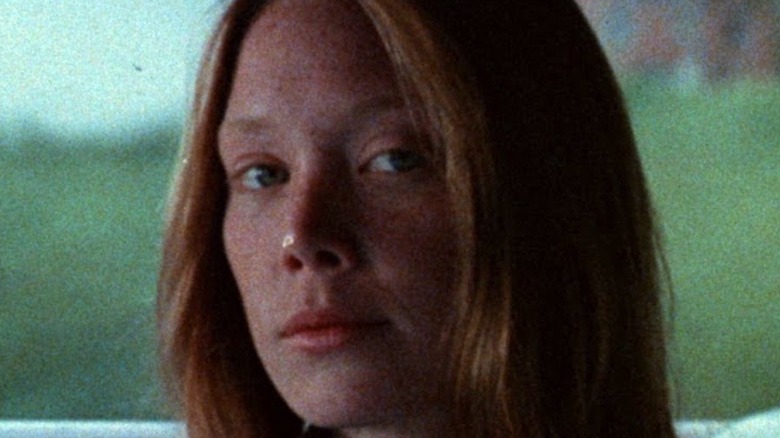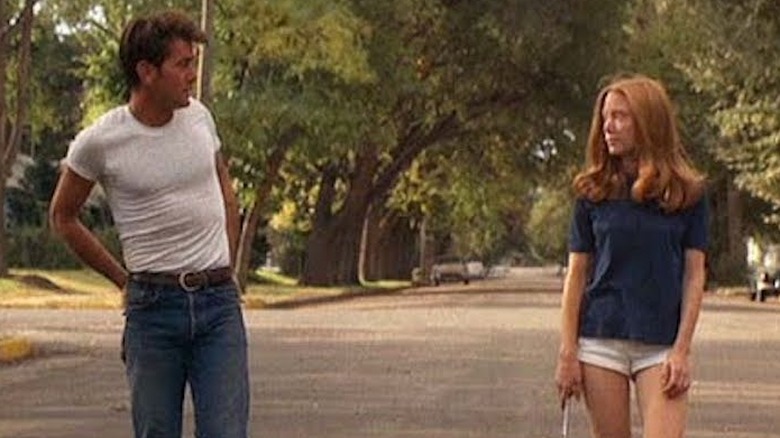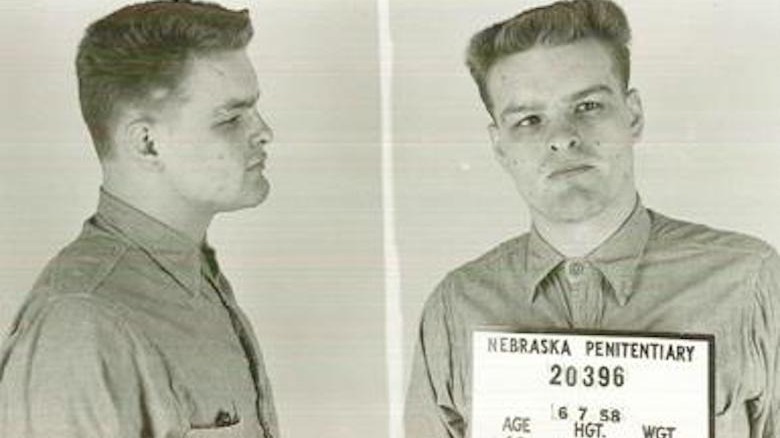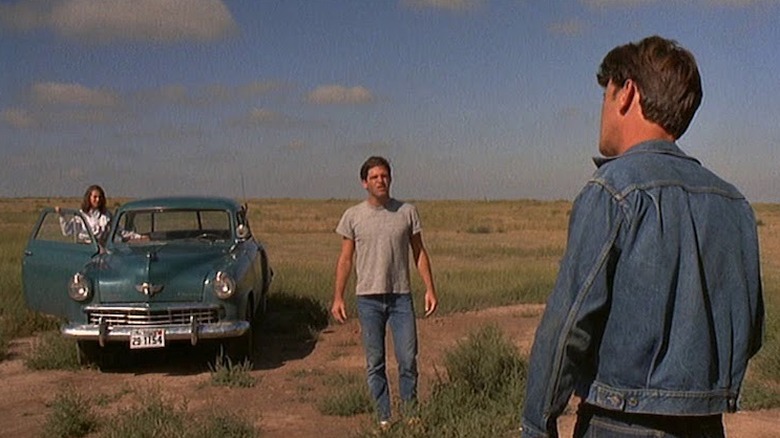How Accurate Is The 1973 Movie Badlands?
Throughout history, there have been so many examples of "killer couples," but few were younger — or more notorious — than Nebraska teenagers Charles Starkweather and Caril Ann Fugate. Their tale — and the series of murders they allegedly committed in 1958 — served as the inspiration for several movies and TV miniseries (via Criminal Element), and while the 1994 film "Natural Born Killers" may immediately come to mind for most people, there was another movie that was released two decades earlier and was arguably more faithful to the story of Starkweather and Fugate.
The film in question was Terrence Malick's "Badlands," which came out in 1973 and starred Martin Sheen and Sissy Spacek as Kit Carruthers and Holly Sargis, a young couple that goes on the run from the law after Kit kills Holly's father. As the film progresses, more murders occur, and viewers get to sympathize with Holly, who finds herself increasingly uncomfortable with her violent and unhinged boyfriend's actions. But beyond the similar setting (South Dakota, circa 1959), how accurate is "Badlands" in relation to the timeline of the Starkweather murders of the late 1950s, and the fates the movie's characters met when they were finally brought to justice?
The names and ages were changed
The main thing to remember about "Badlands" is that the film was loosely based on a true story. In other words, Martin Sheen's Kit Carruthers and Sissy Spacek's Holly Sargis may have been inspired by Charles Starkweather and Caril Ann Fugate, but the fact that the names were changed suggests that they weren't meant to be cut-and-dry movie versions of their real-life counterparts. Then there's also the matter of the characters' ages vs. those of their non-fictional equivalents — Kit and Holly are 25 and 15 years old respectively at the start of the movie (Bright Lights Film), while Starkweather and Fugate were younger. Per All That's Interesting, Fugate was only 13 years old when she first met the 18-year-old Starkweather in 1956.
The original plan for "Badlands" was for the Kit character to be 19 years old – Starkweather's age when he committed his first murder. At the time he auditioned for the role, Sheen was 31, and even in an industry where it's not uncommon for young adults to play teen characters, he felt he was too old to convincingly play an older teen (via IndieWire). But since Sheen was so impressive during his audition, director Terrence Malick made the decision to make Kit more than a half-decade older. This allowed Sheen to portray a more age-appropriate character, one that he felt was the most important role of his career thus far.
Kit and Starkweather had similar backgrounds, but Holly and Fugate didn't
The term "loosely based on a true story" allows for all sorts of liberties to be taken with characters inspired by real people, but that wasn't the case with the occupations of the fictional Kit Carruthers and the real-life Charles Starkweather. It's established early on that Kit makes a living as a garbageman (at least before he quits that job), and while Starkweather was working at a Western Union newspaper warehouse at the time he and Caril Ann Fugate started dating (via Murderpedia), he found work as a trash collector after he got fired for what was allegedly his extreme incompetence. There is one notable wrinkle — as Kit is supposed to be 25 years old in "Badlands," he was written as a Korean War veteran, whereas Starkweather was too young to serve at the time that war was raging.
Before meeting Starkweather, Fugate was known for being rebellious, ill-tempered, and a poor student. She was later introduced to the high school dropout/James Dean-wannabe because her sister Barbara was dating one of Starkweather's friends. Such a narrative is not included in "Badlands," as the film highlights how Holly Sargis started out as a seemingly well-behaved, precocious small-town teenager with a talent for baton twirling. However, things are different at home, where Holly and her father haven't been on the best of terms since her mother's death; Fugate, on the other hand, lived with her mother, stepfather, and infant half-sister.
Starkweather's crimes were far more violent
In "Badlands," the crime that really gets things going for Kit Carruthers and Holly Sargis as a couple on the run is the murder of Holly's unnamed father (Warren Oates), who had forbidden her from seeing her much older, disreputable boyfriend. It all plays out relatively quickly, as Holly's father threatens to call the police he catches Kit trying to convince her to run away with him; KIt reacts by shooting the older man dead. The couple then burns down the house and fakes their death, allowing them to flee to the film's titular badlands.
As explained by True Myth Media, Charles Starkweather did much more than just kill one of his girlfriend's family members on January 21, 1958. After shooting Caril Ann Fugate's stepfather and mother, Marion and Velda Bartlett, with a shotgun, he strangled and stabbed their 2-year-old daughter, Betty Jean. At the time of the murders, Fugate was not home, though there are some similarities in the sense that Starkweather killed the Bartletts following an argument with the couple. Another difference between reel- and real life is the fact that instead of burning the house down with her boyfriend, Fugate dissuaded visitors from coming in with a handwritten note that read, "Stay a Way Every Body is sick with the Flue [sic]. – Velda Bartlett." Starkweather and Fugate would only leave six days later, on January 27, when police arrived at the Bartlett residence.
The reel- and real-life killers both killed a lot of people
We've seen how there were differences between the initial murders committed by the fictional Kit Carruthers and the real-life Charles Starkweather, but what about the murders that took place while they were on the run? After a period of bliss where Kit and Holly live off the land through legal (fishing) and illegal (stealing chickens) means alike, the couple is spotted by three men who Kit claims are bounty hunters — he kills all three, and he and Holly find a new hiding place thanks to Kit's former coworker Cato (Ramon Bieri). However, Cato isn't long for this world as KIt murders him when he tries to seek assistance for the couple. Finally, Kit kills a man and woman who had stopped by to visit Cato, giving him a total of seven murders, including Holly's father earlier in the film.
Starkweather was a substantially more brutal killer in the real world; after killing Marion, Velda, and Betty Jean Bartlett, he took the life of August Meyer, a family friend. His next victims were teenage couple Robert Jensen and Carol King — during his trial, Starkweather claimed he shot Jensen while Fugate did the same to King. Soon after, Clara Ward and Lillian Fencl were both stabbed to death — once again, Starkweather accused his girlfriend of playing a significant role in the deaths of the two women. He then shot Clara's husband, Lauer, when he returned home that night. Lastly, he took the life of traveling salesman Merle Collison.
Prior to all of those crimes, however, there was one more victim to bring the total up to 11 — gas station attendant Robert Colvert, whom Starkweather killed on December 1, 1957, one day after Colvert refused to let him buy a gift for Fugate on store credit.
Holly got a happy ending while Fugate didn't ... at least at first
On June 25, 1959, Charles Starkweather, then aged 20, was executed at the Nebraska State Penitentiary, having been sentenced to death by electric chair for his violent crimes (via Murderpedia). His fictional counterpart in "Badlands," Kit Carruthers, was also executed toward the end of the film. That's where the similarities end, as Holly Sargis had a much better fate than Caril Ann Fugate — she only received probation for her involvement in her boyfriend's crimes, and she even ended up marrying the son of her defense lawyer. All's well that ends well for a young, naive teenager who was portrayed as an unwilling participant in Kit's killing spree.
There was no Hollywood ending for Fugate, who, like Starkweather, was tried as an adult; she became the youngest female to ever be tried for first-degree murder. Maintaining her innocence throughout the trial, she was nonetheless sentenced to life in prison at the Nebraska Center for Women due to her young age. In 1976, after spending much of her 17 years behind bars as a model prisoner, she was paroled, and she went on to live a quiet life as a medical technician and janitorial assistant before retiring. Fugate later married a man named Frederick Clair, though he was tragically killed in a vehicular accident in 2013 (via the San Diego Union-Tribune).





